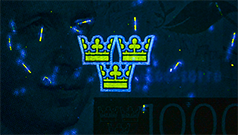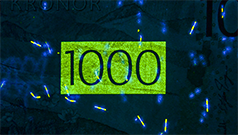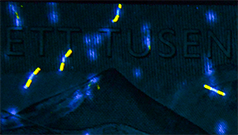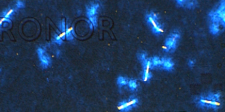Security features
Swedish banknotes are sometimes counterfeited, even if this is very unusual. Swedish banknotes have advanced security features, so that they are difficult to counterfeit and it is easy to check whether they are genuine.
When you check a banknote, you should examine a combination of several security details.
Security strip
Denominations 1,000, 500, 200 and 100
The banknote has a vertical security strip with three windows. The windows feature images that move and alternate motif between "KR" and a royal crown when the banknote is tilted. The security strip is placed to the left of the portrait on the obverse of the banknote. The placement of the security strip may vary by up to 2 cm.
The security strip have the following colours:
1,000-krona banknote: purple
500-krona banknote: red
200-krona banknote: green
100-krona banknote: blue

security strip on 200-krona banknote
Colour-shifting image
All denominations
The banknote has an image linked to the individual portrayed on the banknote. The banknote's denomination is also shown in the image. The image and the denomination gradually change colour between gold and green when you tilt the banknote. The image is placed to the right of the portrait on the face of the banknote.
The colour-shifting images have the following motifs:
1,000-krona banknote: Olive branch
500-krona banknote: G-clef
200-krona banknote: Clapperboard
100-krona banknote: Strip of film
50-krona banknote: Ship
20-krona banknote: Book

Colour-shifting image on 1,000-krona banknote
Watermark
All denominations
The watermark is visible from both sides when the banknote is held to the light. The watermark depicts the denomination of the banknote and its portrait. The denomination appears significantly lighter than the rest of the paper.

Watermarks on 20-krona, 50-krona and 500-krona banknotes
Intaglio printing
All denominations
Intaglio print makes the paper feel like a banknote and gives it a noticeable raised surface – run your thumb over it or scrape lightly with a fingernail. Among other places, intaglio printing has been used for the portrait and denomination on the obverse of the banknote.

Intaglio printing on 100-krona banknote
See-through picture
All denominations
The see-through picture is a pattern on the obverse of the banknote that, together with a pattern on the reverse, forms the denomination when you hold the banknote to the light.

See-through picture on 500-krona banknote
Security thread
All denominations
The security thread is visible as a dark line when you hold the banknote up to the light. The thread is embedded in the banknote paper.

Security thread on all six banknote denominations
Micro- and minitexts
All denominations
Micro- and minitexts can be found on both sides of the banknote. The texts can be read with the aid of a magnifying glass.

Microtexts on 200-krona banknote

Minitexts on 20-krona and 1,000-krona banknotes
Ultraviolet image, obverse
All denominations
The banknote features an image on the obverse that fluoresces (glows) yellow and blue under ultraviolet light.

Ultraviolet image of three crowns on the 1,000-krona banknote's obverse
Ultraviolet image, reverse
All denominations
The banknote features an image on the reverse that fluoresces (glows) green under ultraviolet light.

Ultraviolet image with the banknote's denomination on the reverse, here on the 1,000-krona banknote
Ultraviolet fibres
All denominations
The banknote includes fibres that fluoresce (glow) yellow and blue under ultraviolet light on both sides.

Ultraviolet fibres on 1,000-krona banknote
Some series of banknotes have a brighter blue colour (see picture below). The Riksbank has been informed that certain cash registers and currency-counting machines therefore do not accept them. The banknotes are still valid and can be used to make payments. Nevertheless, the machinery manufacturers are updating their machines to accept the brighter banknotes.

Ultraviolet fibres on 500-krona banknote
(Tactile) markings for visually-impaired people
50-krona banknote
The banknote's short edge features three intaglio lines, placed in three locations.
100-krona banknote
The banknote's short edge features three intaglio lines, placed in two locations.
200-krona banknote
The banknote's short edge features three intaglio lines, placed in one location.
500-krona banknote
The banknote's short edge features three intaglio lines, placed in one location.
20-krona and 1,000-krona banknotes have no lines.

Tactile markings on 50-krona, 100-krona, 200-krona and 500-krona banknotes.
Why are the security strips in different places on the banknotes?
The sideways position of the security strip on the 100, 200, 500 and 1,000-krona banknotes may vary somewhat from one banknote to another. This variation arises naturally in the banknote printing process, and is thus not a printing error. The size of the banknotes can also vary by +/- 1 mm and this is also a natural variation that arises in the printing process. If one measures from the left-hand side of the banknote to the left edge of the security band on the banknotes, the measurements differ as follows:
| Denomination | Number of mm from left edge of note to left edge of security strip on note |
| 100 | 22,25 mm - 41,25 mm |
| 200 | 23,75 mm - 42,25 mm |
| 500 | 23,75 mm - 42,25 mm |
| 1000 | 23,75 mm - 42,25 mm |
Why is there occasional variation in colour?
Banknotes are produced in a printing process and deviations can therefore occur, even if they are unusual. There is just such a minor colour deviation on the reverse of some 1,000 krona banknotes, where the purple colour is slightly paler than normal. This affects neither the function of the banknote nor its security features – it is valid as a means of payment and can be used exactly as normal. To check whether the banknote is valid, you should tilt it. You will then see images that change colour and images that move and shift between motifs.
Counterfeit banknotes and coins
Payments may not be made using counterfeit banknotes and coins. To do so deliberately is a serious crime that is punishable by a prison sentence. It is also punishable to possess counterfeit banknotes or coins with the intention of distributing them.
If you detect a counterfeit banknote or coin, refuse to accept the banknote or coin. If you have already accepted a counterfeit banknote or coin, try to remember how you might have obtained it and report it to the police.
Thanks for your feedback!
Your comment could not be sent, please try again later

Questions? Visit our FAQ on kundo.se (opens i new window).